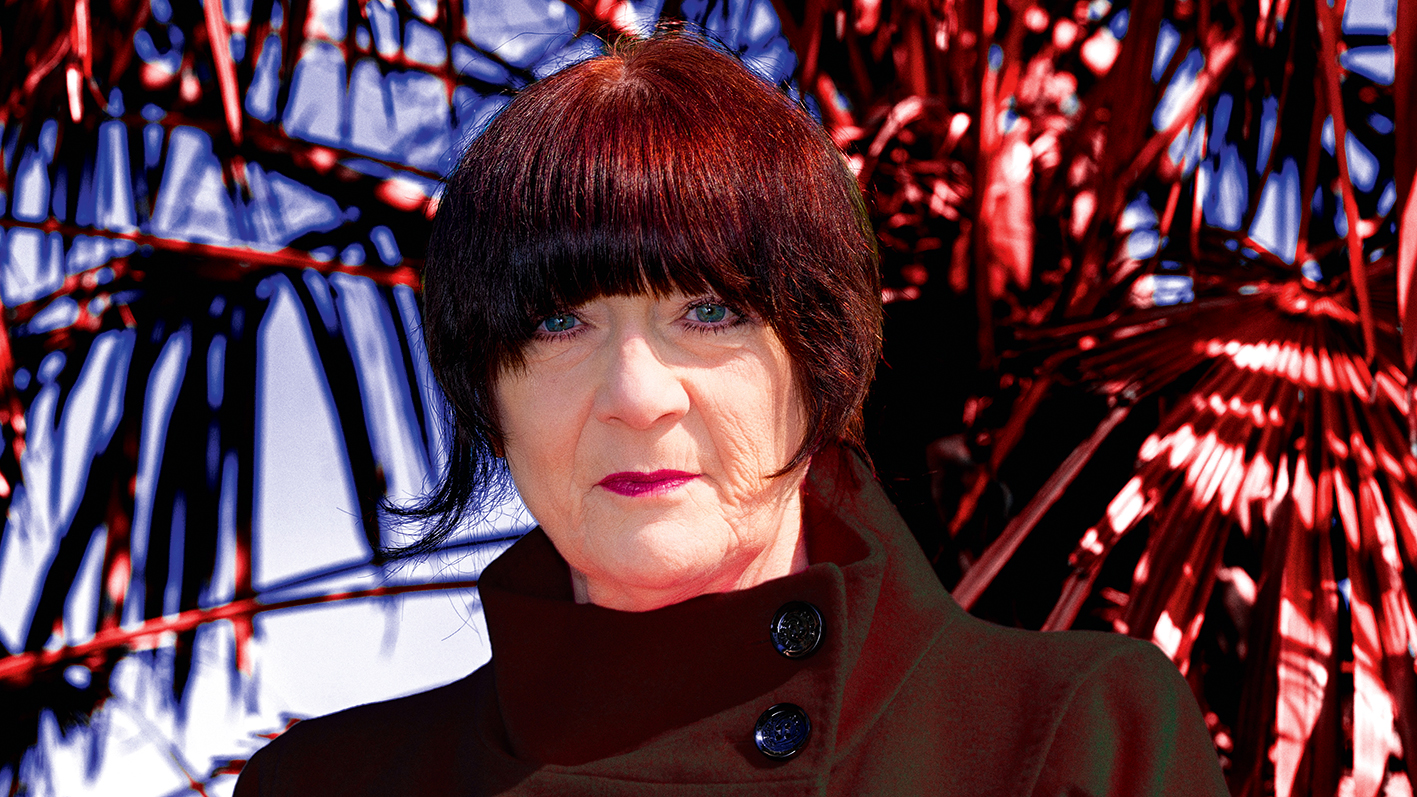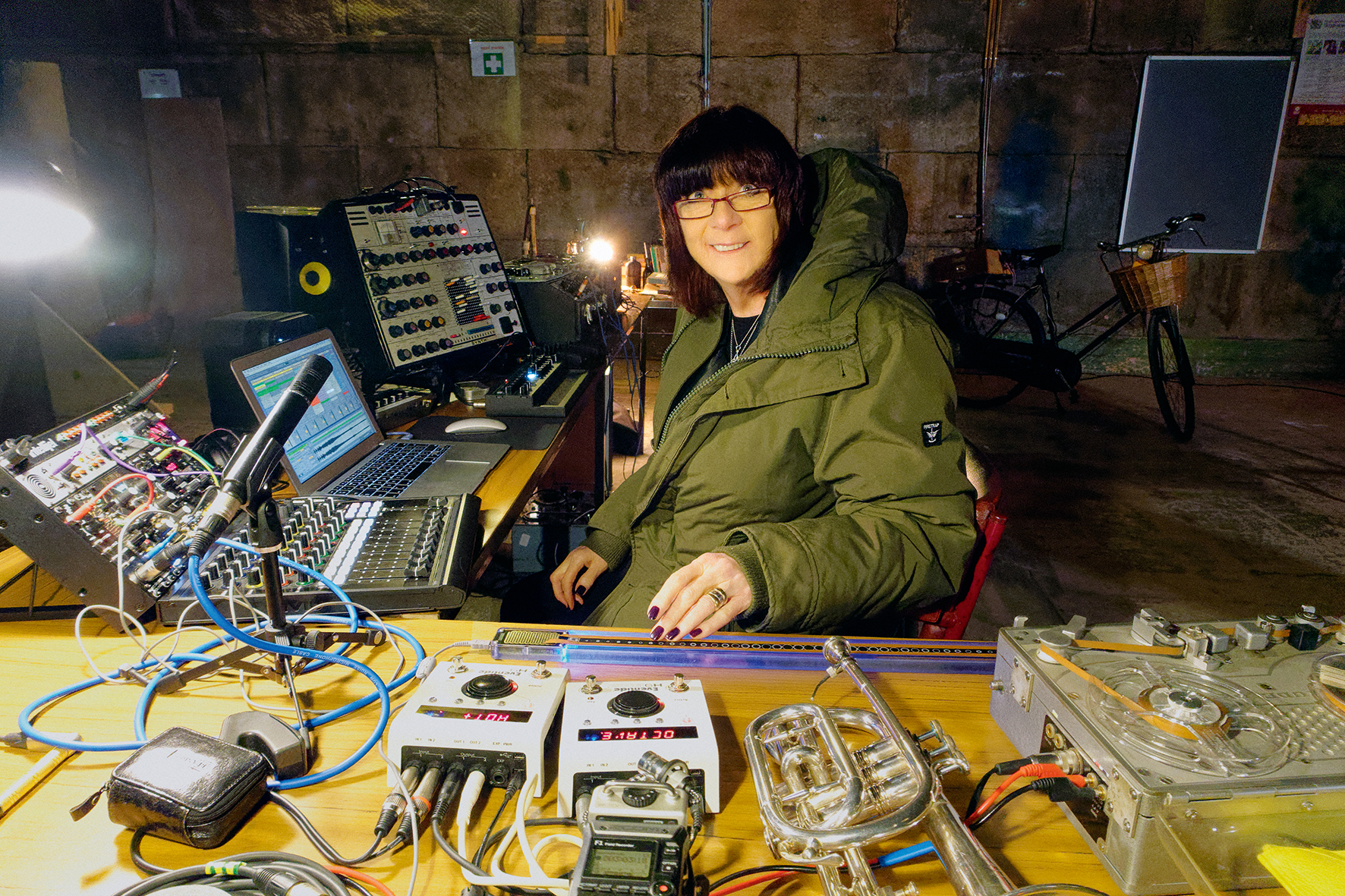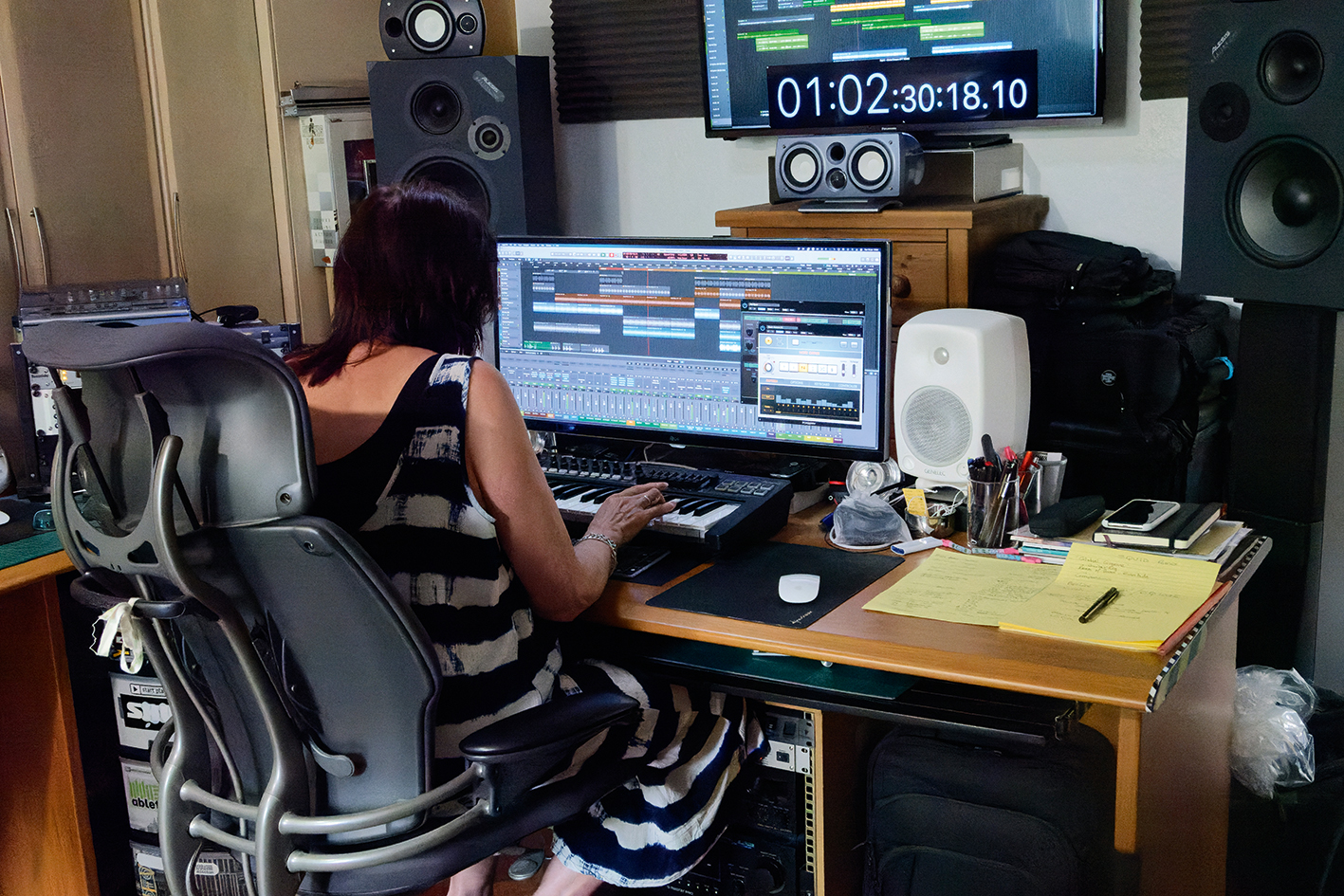Cosey Fanni Tutti: "We’re a long way from resolving the issues faced by female electronic musicians"
Noise pioneer Cosey Fanni Tutti chats to Danny Turner about her soundtrack to the Delia Derbyshire docudrama

A visionary contributor to industrial innovators Throbbing Gristle, one half of avant-garde electronic duo Chris & Cosey and a key member of the surrealistic performance collective COUM Transmissions, Cosey Fanni Tutti has remained fiercely loyal to her subversive, often confrontational, approach to music making, whether using vocals, electronics or traditional instruments.
Tutti’s decades of experimentation therefore made her Caroline Catz’s number one choice to score the soon-to-be-released soundtrack for the filmmaker’s intimate portrayal of sonic experimentalist Delia Derbyshire in Delia Derbyshire: The Myths and the Legendary Tapes. With access to Derbyshire’s audio archive, Tutti integrated her own stylistic approach based on their shared ideologies and the late composer’s compositional notes.
Any teenager will have marvelled at Delia Derbyshire’s original Dr Who Theme in the mid-’60s. Did it have a similar effect on you?
“I was only about 11 at the time so I was a bit too young for marvelling compared to what other music teenagers were into. Also, my dad was into electronics so I’d grown up with what people at the time thought were ‘strange noises’. But I did think it was a great and exciting piece of music; it stood out from everything else that was on TV and radio too.”
For those who may not know, in what other areas of electronic music was Derbyshire an innovator?
“Well the Dr Who theme tune was created using her incredible tape editing and looping skills, but she first had to find the sounds to work with and that’s what made her such an innovator, especially her expertise in developing particular techniques when recording unusual sounds, repurposing and then transforming them into musical form in order to get to what she ‘heard’ in her head. She broke new ground in the ’60s and ’70s and was always thinking outside the box, effectively ‘sampling’ way before it was known as such.”
Derbyshire didn’t seem to get much credit for bringing avant-garde electronic music to the mainstream. Did sexism play a role in the public’s lack of awareness?
Want all the hottest music and gear news, reviews, deals, features and more, direct to your inbox? Sign up here.
“Sexism definitely played a part in Delia not getting due credit for bringing electronic music into the mainstream. Her goal, right until the end, was to introduce people to the beauty and remarkable diversity of electronic music, but she was often passed over where credits were concerned – as was Daphne Oram and other women who worked at the Radiophonic Workshop.
Sexism definitely played a part in Delia not getting due credit for bringing electronic music into the mainstream
“It was an era of male privilege; women weren’t ‘seen’ let alone regarded as having the skills and talent that was associated with men, and that attitude prevailed at the BBC and in the field of music Delia worked in. That she lasted so long at the RW is testament to her determination and love of electronic music, but at least she got access to the equipment she needed to explore some of her ideas.”
Can you draw parallels to your own career?
“There’s been many moments where I’ve felt my hackles go up when I’ve been spoken to as lesser or disregarded or disrespected because I’m a woman. In Throbbing Gristle, it’s often been assumed that I was ‘just’ the girlfriend of one of the guys in the band. There’s been some progress, but we’re a long way from resolving the issues faced by female electronic musicians.”
Were there similarities between Derbyshire’s experimental approach and yours prior to the formation of Throbbing Gristle in the mid-’70s?
“The music I was involved in prior to TG was largely acoustic, mainly because we didn’t have much money then. We borrowed equipment when we could and some members of COUM had things. Spydeee Gasmantell had a couple of small handmade electronic sound gadgets and Les Maull had a reel-to-reel tape recorder that he used to create backing tracks for some of the performances. He was very experimental, using found sounds and recording nature, then manipulating them by slowing down, playing them backwards and overdubbing.
Lack of finances has played a huge role in my art and music - it forced me to be inventive
“Tape loops and tape manipulation were a significant part of the early TG sound experiments and I was heavily into hardware. My guitar and cornet were processed through effects pedals or occasionally fed through to Chris [Carter] who would do all kinds of weird stuff to the sound, and I’d then feed off that, ‘playing’ my instruments in answer to his manipulations.”
To what extent were limitations a vital part of how you thought about art and music making?
“Lack of finances has played a huge role in my art and music and, although frustrating at the time, I’m thankful for that because it forced me to be inventive. Experimenting with sounds led to unexpected surprises and the discovery of new techniques.
“My first electric guitar was a £10 Raver from Woolworths, because that’s all I could afford, and although it’s been cut down and modified I still have it today. But I wasn’t looking to play the guitar conventionally; I wanted it as a source for making sounds for percussion, weird other-worldly sounds or whatever I could generate by assaulting it with a variety of tools.”
Despite the plethora of gear available today, do you feel that artists are disincentivised to experiment?
“Unfortunately, I’d agree. Choice can be daunting and not necessarily a good thing for the creative soul. Where do you start with so much at your disposal and sounds already processed ‘ready-made’? It’s essential that people continue to experiment to create original sounds that will inspire others to set about discoveries of their own.”
When did you first become aware that Caroline Catz was making a movie about Derbyshire, and what made you want to get involved?
“It was Chris who first mentioned it to me and then I did a book launch for my autobiography at Rough Trade East in 2017 and Caroline came along and introduced herself. She told me about her new film about Delia, and how she’d been to my solo exhibition at Cabinet Gallery in London where she’d seen and loved the music I’d made for my autobiographical film Harmonic Coumaction. We connected immediately and had a couple more meetings to discuss what she had in mind for my contribution. I was thrilled to be asked because it was such a great opportunity and a gift of a project for me.”

To what extent did you work closely with Caroline to reveal the truths of Derbyshire’s career and create a tone for the soundtrack?
“We worked very closely. Caroline had done extensive research into Delia, so when we got together she’d already accumulated an immense amount of information for us to work with. When we brought that together with our own feelings about what Delia had experienced at the RW and her personal life, it all began to gel. We always tried to ‘consult’ Delia throughout the process of deciding which sounds would best represent her feelings, so it was a very female-focused collaboration. In that respect, we could tap into Delia’s mindset as a woman navigating her way through the very male world of electronic music.”
What did you find in Derbyshire’s tape archives and notes that you found immediately inspiring?
“Delia is fascinating on so many levels, so I came across a lot of extremely interesting and inspiring things in the archive. The audio tapes were a joy and particularly interesting for me. To access them was a real privilege, and being able to hear her process, the raw material prior to her working it into music and her voice giving instructions was really fantastic. Some of the sounds she’d recorded reminded me of my own very recent experiments, but her notes and school notebooks were my absolute favourite. To see her thoughts written down were like precious windows into her world. Having discovered how much she hated her work being messed with, I took her notes and audio as reference points. That way, I got a melding of Delia and myself.”
Did you find commonalities between her philosophical approach to music-making and your own?
“There tends to be a focus on Delia using mathematics and being rather methodical and orthodox in her approach to music, but I found there were other elements at play because even she said that she liked to bend the rules. She worked a lot off her emotional responses to sounds and the situations she found herself in, and visuals also had a part in inspiring her. Having discovered that, I’d say there are commonalities in our philosophical approach to making music but I don’t have Delia’s mathematical and classical music skills. That’s actually something I’m very happy about because it gives me a sense of freedom.”

What can you tell us about Twickenham Studio 3 and why you recorded the soundtrack there?
“Only the track Guitar (Twickenham Studio 3) was recorded at Twickenham Studios. My main setup at home was transferred to fit in with what Caroline had in mind for her script. The main pieces of equipment I used were an original BBC Nagra tape recorder, various tape editing tools, including Chris’s original splicing block from the ’70s, a vintage tone generator, a green Coolicon lampshade, cymbals, various mics, cornet, guitar, Roland Space Echo, an EMS Synthi A, and some of Delia’s original Synthi patch sheets.”
Did you attempt to accurately translate those patch sheets?
“Inevitably, when I patched them into my Synthi A they didn’t sound exactly the same, but that was good for me. I just worked until I got something that I felt was needed for a particular section of the film, recorded it quickly before it changed too much and saved it. I also used a Stylophone Gen R8 touch keyboard, a Korg Nano keyboard, my modified ribbon controller, two Eventide H9 pedals, a mixer and my Mac laptop.”
What role did your love of modular play in the creative process?
“Chris built me a small Eurorack case with different modules that I wanted to work with like Intellijel’s FSR Touch Pad, Noise Tools Module and Oscilloscope, plus a preamp for my mic, a Font VCF Filter and an Eventide Digital Delay module. I was also lucky enough to get a prototype of the amazing Instruo Lúbadh Dual Looper module, which has two independent loopers and is very intuitive and brilliant at quickly capturing, looping, overdubbing and manipulating sounds. It’s very visual so you can immediately see what direction and speed your loops are playing back at – a bit like a modern day sophisticated version of what Delia was doing with reel-to-reel tape recorders. The 4ms WAV Stereo Recorder module was also essential to me when working on the fly.”

What’s useful about that device?
“It’s great because it can record in stereo continuously for hours and hours, even days. I had it set up as the last in my chain of Eurorack modules, so anything going through the modular ultimately goes into the WAV Recorder. I put it into record mode as soon as I switched my gear on, so any sounds made during that session were recorded until I eventually had this massive collection of original experimental sounds at my disposal, which I later edited and processed in Ableton Live and Logic Pro for mixing.”
Did you employ any other atypical techniques that were inspired by Derbyshire’s methods?
“I recorded various sounds using the Nagra then made loops that I processed. I also attached a length of ¼” tape containing Delia’s voice to my ribbon controller and dragged a modified tape head along the strip of tape by hand. The signal was fed into my modular effects, which enabled me to get partials of Delia’s voice like she did herself using other methods. I could have done it digitally I suppose but it wouldn’t have been the same and would also have taken me out of ‘Delia mode’.”
How much was the soundtrack creation supplemented by further production work at your Norfolk studio?
“It was mostly a case of mixing and producing what I’d already recorded. Also, I used the Eventide H9000 as not just a multi-effects processor but to generate sounds, drones and tones. It was ‘instrumental’ to certain parts of the soundtrack. The majority of the sequencing was done using the Stylophone Gen R8 built-in sequencer to control the EMS Synthi A, which was then manipulated and recorded in
real time. The TC Fireworx, Eventide Eclipse and Eventide H9000 got a lot of use too, probably more so than any DAW plugins.”
The track Snuff Chorus is quite light-hearted. What can you tell us about some of the sounds/samples used in that track?
“I had a specific brief for this track that referred to Delia’s propensity to sneeze and her starting to take snuff. It had to be in the style of one of Delia’s jolly, witty intros. The samples are Delia’s voice, my own samples of people sneezing, including my grandson, snuff tins opening and closing and the rest is all EMS Synthi A. I use a Zoom F1 recorder for all my field recordings and have a handful of different mics that can be attached to it.”

The soundtrack has a dark tone. Is it equally intended to be representative of Derbyshire’s life as much as her creative contribution to music?
“You can’t have Delia’s music without ‘Delia’ being in there, and there were some very dark moments in her life, some of which were to do with her being frustrated and sad at how she was treated regarding her contribution to electronic music. Due recognition for her work meant a lot to her.”
What effect has working on this soundtrack had on you creatively?
“Working on the film soundtrack and learning so much about Delia had a significant effect on my life, personally and creatively. So much so that I felt I needed to write about not only her musical achievements but ‘Delia’ and how she was inherent in the music she created. She inspired my new book Re-Sisters about three women (15th century mystic and author Margery Kempe, Delia and I) who, despite the problems faced, resisted being categorised or held back from what they wanted to do.”
Do you have plans to play The Myths and the Legendary Tapes in a live environment?
“I was going to perform it live at Coventry Cathedral as part of the City of Culture but I got really ill and had to cancel. I was devastated because I’d seen it as the perfect ending to my time with Delia and Caroline. I don’t have any more plans to play live, but I do have a new artwork of an edition of photographic prints titled ‘INCOGNITO’, and another that I’m really excited about. I’ve also set aside some sounds and ideas that I’d composed for the Delia soundtrack that weren’t right for ‘Delia’, so those will be forming my third solo album.”


Future Music is the number one magazine for today's producers. Packed with technique and technology we'll help you make great new music. All-access artist interviews, in-depth gear reviews, essential production tutorials and much more. Every marvellous monthly edition features reliable reviews of the latest and greatest hardware and software technology and techniques, unparalleled advice, in-depth interviews, sensational free samples and so much more to improve the experience and outcome of your music-making.
